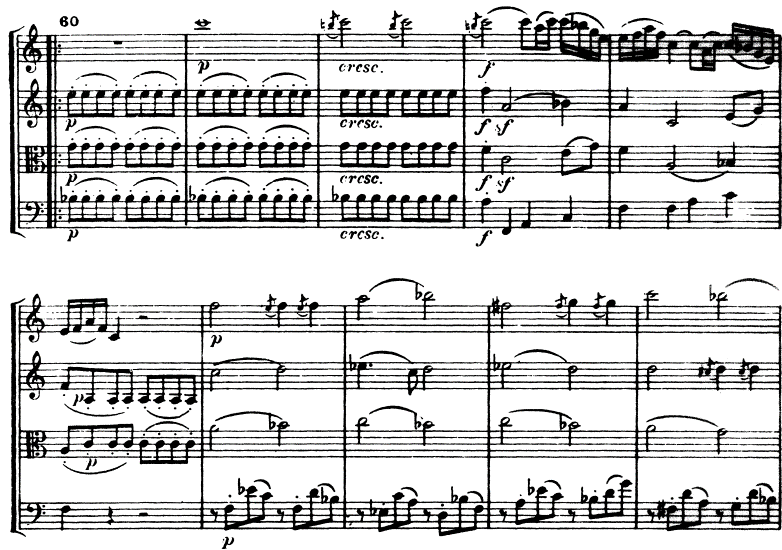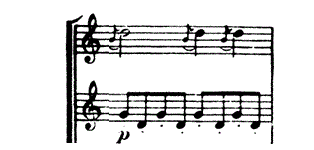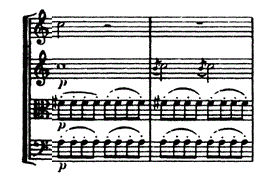The four voices of a string quartet exist within complex relationships. Each instrument maintains a balance by fulfilling primary melodic, secondary melodic, and harmonically or rhythmically supportive roles. The voices of Op. 20 reside within two types of equally occurring textures. In the first texture-type, there is a constant melody supported by harmonic accompaniment whereas in the second, the four voices play equal parts in harmony and melody. In the former type, the violin is usually responsible for primary melodic material while the other three instruments play supportive roles.
The minuet in E♭ major exemplifies the first type of texture. The first violin is consistently involved in the primary melody, and the bottom three instruments are equally as involved in maintaining harmonic support. This texture is thick, and unchanged. Examples of the violin’s primary role can be seen in Op. 20 no. 2. /iii, 20.3/iii, 20.4/ii and iv, and 20.5/i.
In the second type of texture, the four voices are still of equal with balanced importance, but without the tradeoff among roles. In some instances, this texture-type appears monorhythmically, in which all four voices harmonically support each other, but are rhythmically in unison, while at other times, the instruments act as a fugue. Each quartet has one movement (Op. 20, No. 1, third mvt, Op. 20, No. 2, third mvt, Op. 20, No. 3, second mvt, Op. 20, No. 4, third mvt, Op. 20, No. 5.second mvt) in which all four instruments play the same rhythm and harmonically support one another, creating a chorale-like texture. In the three fugues, for which Opus 20 is best known, the voices are naturally and completely balanced; they establish and maintain a consistent, symmetrical texture and play the same material.
The unvarying balanced textures provide little in terms of evolving personality to Op. 20’s melodic material. Many themes in Op. 33, on the other hand, evolve in character throughout one movement. They develop as a narrative over time, and Haydn utilizes texture as his main tool of evolution. One clear example of this use is found in the C major quartet’s first movement. Musicians and musicologists today recognize this piece by its nickname, “The Bird.” Although Haydn himself did not coin this nickname, it is quite evident as to its origin. The moniker refers to the recurring use of grace notes, which create a chirp-like effect. The chirping is heard again and again, and the technique becomes the movement’s main theme. Like a storyteller, Haydn establishes a character, one that is an active member of many habitats. This character’s scenery changes and provides circumstances to which this chirping “bird” adapts. When the character is first introduced, its surrounding elements are thick, like a leafy tree atop which it chirps. The first violin chirps, and the surrounding texture results from the accompaniment of the three remaining instruments. This accompaniment is, at first, quiet and staccato, yet continuous and harmonically strong. The second violin and the viola introduce the “bird’s” surroundings with a stream of unchanging, staccato sixteenth notes in the tonic key. Then, after the first two chirps are heard, the accompanying music crescendos and all three accompanying instruments play relatively slow-moving harmonies to support the melody. (Figure 3.a)
 Figure 3.a Op. 33, No. 3, first mvt, mm. 1-6
Figure 3.a Op. 33, No. 3, first mvt, mm. 1-6
The second appearance of the theme (m. 8) is in D minor, but the texture remains the same as its first appearance. The first time we hear the theme in a new setting, in the dominant, and accompanied by only the second violin (Figure 3.b).
Figure 3.b Op. 33, No. 3, first mvt, mm.43-45
Here the second violin plays a quickly moving accompanying line, providing the theme with more motion than has previously been heard. Furthermore, the theme’s melody is changed: it is quicker and more fragmented. Furthermore in measure 43 the first violin again controls the primary role, but the surrounding elements have changed dramatically since the beginning of the movement. The second violin plays a quickly moving accompaniment, which provides a very thin texture for the first violin’s melody until measure 45. It is clear that Haydn’s four voices do not play the roles in Op. 33 that they played in Op. 20. Instead of holding to a repetitive, consistent balanced structure, the four instruments are used primarily as tools for shaping and developing thematic material. This factor is new to Haydn’s quartets, and will be seen throughout Op. 33.
The cello plays an important role in the new textures of Op. 33. Previous scholars, notably Donald Tovey, have emphasized the cello’s treatment in Haydn’s quartets. In Op. 20, the cello functions primarily as harmonic support or one as one of four equal voices in a fugue. The relatively few passages in which the cello assumes a more active role in Op. 20 (for example, its prominent entry in the fourth measure of the first quartet of the set) have been identified by some critics as moments of notable stylistic innovations; however, it is only in Op. 33 that the cello becomes consistently active alongside its four counterparts in developing thematic material, and thus acting as much more than mere accompaniment. This can be seen in the first movement of Op. 33 no. 3. When the cello first enters, in m. 4, it plays a fairly conventional accompaniment pattern. Throughout the first theme (mm. 1-26) its role is as a traditional bass. Later in the exposition, the cello does enter into thematic dialogue with the other instruments a couple of times (mm. 34-6, 47, 52, and 58).
The cello’s role changes even more prominently in the development section, beginning in measure 60 (Figure 3.c).
 Figure 3.c Op. 33, No. 3, first mvt, mm. 60-69
Figure 3.c Op. 33, No. 3, first mvt, mm. 60-69
The section opens with a similar textural arrangement as is heard at the beginning of the piece, but now the cello sounds much earlier, introducing an important dissonance that creates a secondary 4/2 chord. Six bars later, a motive originally introduced in m. 30 is reintroduced in slightly varied form in m. 66 in the cello’s voice. Here, the cello may not play a prominent role in melodic terms, but it provides a secondary melody to the first violin’s statement of a melodic line derived from the theme that first appeared in m. 43. Moreover, by adapting a motive from earlier in the movement and treating it as counter-melody, this passage displays a new aspect of Haydn’s compositional manner, thus exemplifying what Sandberger famously defined as thematische Arbeit, Haydn’s brilliant new method of thematic evolution. This term loosely translates to “thematic working-out” or “thematic development.” Thematische Arbeit is established in Op. 33 No. 3, and the moment in measure 66 is a perfect example of the technique. The cello takes a theme played by the first violin in measure 30 (Figure 3.d), and uses it in a new setting. This theme is evolving and changing over time, and thus “working out” and “developing” successfully by means of existing within a new texture and taking on a new role.
Figure 3.d Op. 33, No. 3, first mvt, mm. 30-31
Suddenly the cello has become something other than the bass as it was earlier in the piece. It is now active in creating a new texture for the theme, a role it did not possess in its first appearance. The cello certainly did not play this sort of role in Op. 20. There, as we have seen, the cello served as either the basis of harmonic foundation or as a community member in the fugal and choral texture-types, but did not enter into the sort of fluid thematic and textural give-and-take that characterizes Op. 33, and that comprises, we feel, a key element of its “new and entirely special” manner.
Looking ahead to measure 100, the first violin plays this secondary theme that the cello plays in measure 66. Later in the recapitulation, the second violin actually takes on the “bird” theme, as we’ve seen before (Figure 3.e).
Figure 3.e Op. 33, No. 3, first mvt, mm. 100-102
There is juxtaposition between the first and second violin. The second violin repeats the first part of the primary theme, which had been played by the first violin previously. The first violin takes the secondary theme, which we have heard the cello play previously. Now, it is clear that the changing texture is active in creating a narrative, as the themes have evolved, giving our “bird” a new voice.
Directly before its final appearance, the original theme is played (Figure 3.f) in the second violin.
Figure 3.f Op. 33, No. 3, first mvt, mm. 161-167
The theme is quickly interrupted before the first violin grasps its title as “prominent melodic leader” and repeats the opening of the movement in its original texture. Since the chirping has been heard, at this point, in all four voices, and in numerous textural variations, it is difficult for us to hear this finale as a full return of the theme. The textures have forced a dramatic evolution of the original character to the point that it is impossible to argue, or to hear, this final theme as we did at the opening of the movement. The last five measures of the C major movement are the “The End” of a narrative about a “bird” who has migrated to many lands, and has returned a changed, matured, “brand new bird.”
Haydn’s captivating, evolving narrative and happy ending serve to entertain the audience in a clever and subtle way. The thematic development, as seen by Sandberger and other scholars, is a tool to include and interest its listener. This technique is distinct to Op. 33, and is quite witty and clever. In fact, Haydn’s wit and cleverness are a major part of what makes Op. 33 new and special, and it is to these attributes that we now turn.




